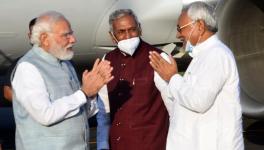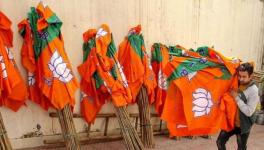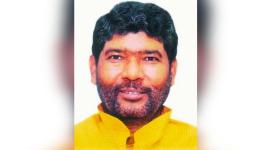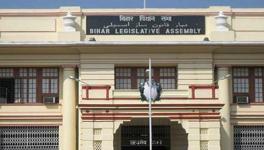COVID-19 in Rural India- XVIII: Impact on the Rural Workforce in Bihar’s Bharri
Representational Image.
This is the 18th report in a series that provides glimpses into the impact of COVID-19-related policies on life in rural India. The series, commissioned by the Society for Social and Economic Research, comprises reports by various scholars who have been conducting village studies in different parts of India. The reports have been prepared on the basis of telephonic interviews with key informants in their study villages. This report talks about the impact of the lockdown on the maize harvesting as well on the overall economy of the Bharri village in Katihar district of Bihar.
Bharri is a village in Katihar district in the state of Bihar. It is almost equidistant from two district centres, namely Purnia and Katihar, and is well connected to both. The village is in the Barsoi subdivision, and lies in the catchment area of the Mahananda River, which also separates this subdivision from West Bengal. The embankment in the catchment area makes this village prone to flooding almost every year during the long monsoon season.
Because of the highly irregular pattern of flooding, both in terms of timing and extent, the cropping pattern in this region has changed significantly over the last couple of decades. Owing to the suitability of the terrain, kharif paddy was the most important crop in this region for several decades, but the farmers of this village have gradually shifted to rabi crops such as maize and mustard as well as garma paddy. Often referred as the maize capital of Katihar, Bharri has routinely achieved one of the highest maize yields in the state for almost a decade now. During the rabi season, more than 80% of the land is engaged in maize cultivation. The cropping intensity in the village has increased in the last three years. An overwhelming proportion of cultivable land is now double-cropped—the kharif paddy crop is followed by rabi maize.
The primary occupation of most inhabitants of the village is agriculture. Land distribution is skewed, and there are many small and marginal farmers in the village. One family in the village owns nearly 250 acres and another family nearly 75 acres. A large number of households own only residential land. The majority of households have less than half an acre of land and large areas of land are used to cultivate maize under cash leases. The cost of a lease (for maize cultivation) varies from Rs 13,000 to 18,000 per acre depending on the quality of land.
Some individuals are self-employed in non-agricultural occupations, such as running small shops (there is a small chowk in the middle of the village with 20-30 shops, including one relatively big fertiliser distributor who caters to about five nearby villages), or driving auto rickshaws or small carriage vehicles (the vehicles are usually owned by the family of the driver).
Impact on the agricultural sector
Given the centrality of maize to this region, any impact on maize cultivation is bound to impact the economy of the entire village. The cultivation of maize requires timely use of fertilisers and irrigation, as these are the most important determiners of productivity. The lockdown has interrupted this. For instance, a number of cultivators reported that the supply of fertilisers to the village was delayed by nearly 10 days after the announcement of the lockdown. This occurred during the peak period for fertiliser application to the maize crop. The availability of diesel was also a concern during the first 10 days of the lockdown. Also, a sharp rise (more than 15%) in diesel prices was reported at the local level during the lockdown. The rise in diesel prices also raised the cost of garma paddy cultivation.
Also read: Why India Should Let Migrant Workers Return Home
This dire situation is further compounded by lack of access to cash for the timely purchase of fertilisers, diesel and other inputs. This has caused a sharp, visible fall in total fertiliser use in the village, as evinced by the sales reports provided by the fertiliser distributors: during the peak period last year, fertiliser sales crossed Rs 1 lakh per day (for a period of at least 15 days), but during the same period this year, the average sales remained lower than Rs 10,000 per day. One of the respondents was of the opinion that the lockdown has directly caused this decline for two reasons: lack of access to cash and disruption of transport. Nearby villages have been severely hit as well, since they too rely on the fertiliser distributor in Bharri. It is possible that the impact of the low use of agricultural inputs may be seen in lower yields of maize as well as garma paddy in this village, and perhaps also in the nearby villages.
Farmers have also found it difficult to sell their grain and produce at this time. There is a co-operative in the village that generally procures paddy from the farmers, but procurement has stopped during the lockdown. One of the farmers reported that the most recent kharif paddy yield in the village was very good, and he did not sell his produce just after harvesting it in December primarily because there was a possibility of a price rise in the coming months, and he wished to use the money he would earn to purchase fertiliser for his maize crop. But the price of paddy has fallen during the lockdown from more than Rs 1,600 per quintal to less than 1,200, and there are no buyers. In the absence of income, the farmer resorted to borrowing from a local money lender at the rate of 6% per month (a 72% annual rate) in order to buy fertiliser. He was only able to purchase half of the total quantity of fertiliser that he had used last year for the same area of land. A similar issue was reported by wheat farmers—there has been a sharp fall in prices from nearly Rs 1,800 to Rs 1,100 before and during the lockdown respectively.
Most of the farmers were extremely worried about the lockdown being extended and the impact this would have on the sales of produce. According to one respondent, the lockdown had not affected operations thus far, since the paddy harvest is complete and the maize is still ripening. The maize harvest is expected to occur between the last week of April and the middle of May; so, a lockdown extension could impact this. The harvesting of maize and post-harvesting activities require labour. Also, most farmers in Bharri sell their produce just after the harvest to external buyers from different regions of the country, the lockdown would disrupt both the transport of goods to the market and the presence of potential buyers. Most of these farmers do not have adequate storage facilities or the financial means to face a delay in the selling of their harvests.
Access to banks
The nearest branch of the State Bank of India is five kilometre away from Bharri and handles the Jan Dhan Yojana for the entire block. The respondents were unequivocal about the difficulty in withdrawing money from this bank. In spite of standing in line from as early as 5 am, only about one-third of the people, on average, were reported to have been successful in withdrawing money. One of the respondents reported having stood in line all day on two different occasions to no avail. An alternative method of getting cash was through the ‘customer service point’ (CSP) in Bharri Chowk. However, the CSP attaches high charges—Rs 10 per thousand and sometimes even more—and usually has only a limited stock of cash insufficient for the long queues that form outside.
Issues relating to livestock
Livestock farming is one of the major sources of diversification of income in Bharri. Unfortunately, livestock owners have found it increasingly difficult to access fodder during the lockdown. The price of wheat straw has nearly doubled, and is now over Rs 1,000 per quintal. One respondent, who owns a buffalo, reported that he initially relied on his stock of fodder, which was now almost exhausted. If the lockdown were to be extended, access to fodder would be difficult for two reasons: he could neither take his buffalo to common grazing lands nor could he buy fodder as there is an acute shortage of fodder in the villages (through lack of procurement). The respondent had decided to sell his buffalo, but failed to find a buyer. Also, because of the sharp fall in the labour income in the village, the demand for milk has dropped significantly. Milkmen from other villages have also not come to buy milk due to the lack of transport.
Also read: Lockdown: Fear, Anxiety Grips Kashmiri Traders Stranded in Lucknow
Impact on the labouring population
There is hardly any manual work available in the village and nobody is allowed to go out for work. This has had an enormous impact on the labouring population of the village. Most of the respondents reported that their savings were almost totally exhausted and they are unable to borrow even at higher rates of interest. MNREGA work has totally stopped and these respondents have no source of income to support their families, especially in households in which all members were employed in manual work. Some labouring households depended on remittances sent by one or more family members working outside the village as migrant labourer/s. However, the lockdown has made it even worse for these migrant labourers. One respondent said that his son, who was working in Ghaziabad, had sent him Rs 5,000 two months ago, but in the absence of work, the son had now asked the father to send him at least Rs 2,000 for food and essential items. A migrant labourer working as a regular salaried worker in a glass shop in Katihar reported that he has lost his job since the lockdown began. While his employer had given him Rs 2,000, it had lasted only a few days— his survival is now at stake. Respondents who had at least one family member working outside the state reported that migrants were unable to earn any income and were even resorting to reverse remittances. Some migrant workers came back to the village for Holi and have been stuck here with no work. In recent years, there has been a feminisation of the workforce in the villages due to excessive male out migration. In the absence of farm employment, many female workers are losing out on a significant part of their family income.
Impact on availability of food items
Immediately after the lockdown began, there was a sharp increase in food prices. The local administration intervened and the prices were lowered, but they are still 50% higher now than before the lockdown. Bharri Chowk is closed and the nearest shops are around three and a half kilometres away. The absence of transport and a lack of cash have rendered the villagers vulnerable, with many having to rely only on lentils and saag—respondents reported that even one vegetable in a meal is a luxury. One respondent reported that his family’s stock of vegetables was fast depleting and purchasing them at higher prices would not be feasible for long.
Impact on non-agricultural employment
Given the strategic location of Bharri, some households had diversified into the transportation business, and had taken out loans to buy auto-rickshaws, cargo carriers and other vehicles. Commensurate with their prices, the monthly installments for these vary from Rs 13,000 per month to Rs 20,000 per month. Since the lockdown began, such vehicles have not been used and have therefore not generated any income at all. The savings of families that depended on this income are dwindling and the situation is grim for those who are totally dependent on this income, both for their survival as well as the repayment of their loans. Even some of the regular salaried respondents reported delays in their monthly salaries being paid.
Government/civil society and other external support
Although relief packages have been announced, these benefits have not materialised for the affected population in Bharri. Respondents reported that they had received Rs 800 towards the refilling of their LPG cylinders. Some households had also received Rs 500 as a form of financial support—some perceived this to be for lighting diyas, as requested by the prime minister. A fairly small number of farmers had also received Rs 2000 under the Kisan Samman Yojana. Apart from such government initiatives, no civil society, village panchayat or other organisations were reported to have provided any sort of support to the villagers.
The rural population, particularly small farmers and labourers, in Bharri is facing an acute financial and social crisis. It is likely that this will only worsen given the extension of the lockdown until May 3, 2020. While lockdown is required to deal with the pandemic at hand, it comes with the risk of further endangering the lives of the most vulnerable. Active support from the government as well as civil society is necessary.
Author is an associate professor at the O P Jindal Global University.
Get the latest reports & analysis with people's perspective on Protests, movements & deep analytical videos, discussions of the current affairs in your Telegram app. Subscribe to NewsClick's Telegram channel & get Real-Time updates on stories, as they get published on our website.





















